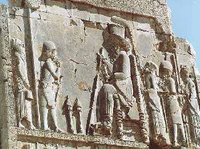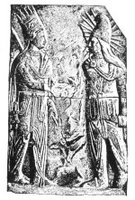Marlik Culture

Marlik culture was discovered in the green and fertile lands of Northern Iran just South of the Caspian Sea. The amazing archeological founds on this site are associated with 10th-12th century BC. Some researchers believe that Marlik has attained its name from the innumerable snakes that have inhabited it. (As 'Mar' means snake in the Persian language). Whereas, some believe that, Marlik, the name the local villagers gave to the mound, is 'Marda-lik' (place of the Marda or Amarda), and the Greek historian Strabo describes the Marda as living in this part of Ancient Persia. There are some significant similarities between the metalwork at Marlik and some of those found at Sialk near Kashan, and as the finds at Sialk are dated as slightly later than those of Marlik, it is suggested that the Amarda around Marlik and the Sepid Rud, relocated to the central Iranian plateau near Sialk where they were eventually assimilated into the general Median population. In the excavations performed on this site, a large number of broken earthenware pieces can be noted. Moreover, two tiny statues of cows in admiralty metal, two cylindrical seals, fourteen gold buttons and other unique objects have been discovered. In this hillock, there is the remnants of a quadrangular structure with an approximate area of 30 sq. m. the same probably being a tomb or temple.
This hillock was also a site where the local commanders or princes who ruled in the
 2nd or 1st millennium BC. were laid to rest. According to the tradition of the times, the dead were buried along with their treasures. About 25 tombs have been discovered, in some of which are human carcases, besides which, articles such as earthenware and bronze vessels, decorative buttons, arrows, swords, spears, bronze and earthenware statues, daggers, hemlets and etc. have been discovered. Fabrics from this site determine the fact that weaving was a progressive technology in Iran thousands of years ago, and more so in Gilan. About 11 seals have been discovered in these excavations, and these have interesting designs and patterns on them. There is a seal engraved in the Cuneiform script. The people who buried their dead at Marlik remain something of a puzzle for history. They seem not to have left any written records, and aside from the cemetary at Marlik there is not very much in the archaeological record to fill out their history.
2nd or 1st millennium BC. were laid to rest. According to the tradition of the times, the dead were buried along with their treasures. About 25 tombs have been discovered, in some of which are human carcases, besides which, articles such as earthenware and bronze vessels, decorative buttons, arrows, swords, spears, bronze and earthenware statues, daggers, hemlets and etc. have been discovered. Fabrics from this site determine the fact that weaving was a progressive technology in Iran thousands of years ago, and more so in Gilan. About 11 seals have been discovered in these excavations, and these have interesting designs and patterns on them. There is a seal engraved in the Cuneiform script. The people who buried their dead at Marlik remain something of a puzzle for history. They seem not to have left any written records, and aside from the cemetary at Marlik there is not very much in the archaeological record to fill out their history.If the original population abandoned the valley soon after the burials, this may explain why the cemetary was forgotten and not looted in the intervening years. This theory still remains unconfirmed, and it remains true that little can be said with any certainty about the people who buried their royalty atop the mound at Marlik. The artifacts recovered at Marlik contain many unusual items which have helped to develop current thinking on the chronology of metal working in late bronze age cultures. It is significant to note that without scientific excavation procedures, it would have been impossible to date and locate these items, and it would have been impossible to appreciate their unique and important place in the archaeological re
 cord.
cord.After all their trials and travails, the archaeologists at Marlik were ordered to abandon the site in November of 1962 after a change in government which brought the allies of the smugglers and antique dealers, some of which were in the family of the Shah, to power. Forced to abandon the excavation, there was little that could be done other than return to Teheran to appeal the decision. When a team was permitted to return to the mound one year later, it was clear that little more could be done as the entire area had been ravaged by illegal digging. A brief survey showed some 2000 holes had been haphazardly dug around the valley, and everything that had been despoiled was now lost to history. It is difficult to say what was destroyed, and to this date the only material of the Marlik people to be available to science is the collection from the excavation which is housed at the Muzeh Iran Bastan (Archaeological Museum in Teheran).
Recently Archaeologists have gone back to this site for new excavations. Their efforts have led into new developments in our understanding of Marlik architecture and new artifact discoveries.




